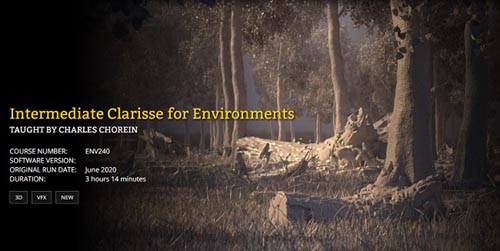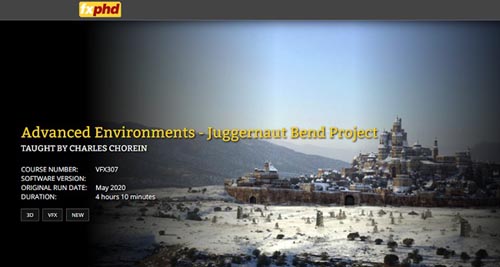FXPHD – ENV150 – Introduction to Clarisse for Environments
cod2war
11-May-20
0
Related Articles
FXPHD – CLS101-Introduction to Clarisse
On 11-May-20
by
FXPHD – CLS101-Introduction to Clarisse Duration 3h 14...
FXPHD – CLS101-Introduction to Clarisse Duration 3h 14...
FXPHD – ENV240 Intermediate Clarisse for Environments
On 06-Aug-20
by
FXPHD – ENV240 Intermediate Clarisse for Environments...
FXPHD – ENV240 Intermediate Clarisse for Environments...
FXPHD – VFX307 – Advanced Environments – Juggernaut Bend Project
On 15-Aug-20
by
FXPHD – VFX307 – Advanced Environments – Juggernaut...
FXPHD – VFX307 – Advanced Environments – Juggernaut...
The Gnomon Workshop - Introduction to Clarisse v4 with Alessandro Cangelosi
On 14-Jun-19
by
The Gnomon Workshop – Introduction to Clarisse v4 with...
The Gnomon Workshop – Introduction to Clarisse v4 with...
[Tutorials] FXPHD : VRY102 Introduction to V-Ray 3 for Maya
On 14-May-16
by
FXPHD : VRY102 Introduction to V-Ray 3 for Maya | 4.0 GB...
FXPHD : VRY102 Introduction to V-Ray 3 for Maya | 4.0 GB...

FXPHD – ENV150 – Introduction to Clarisse for Environments
Duration 4h 14m Project Files Included MP4
==========
Info:
CLASS 1: INTERFACE
This class is focused on understanding the interface and the mindset of Clarisse. You will learn how to create a camera and manipulate basic objects to create a layout. This includes creating lights and importing an alembic file from Maya to set up a basic Clarisse scene.
CLASS 2: THE RENDER ENGINE
Assigning shaders and going through the Standard shader parameters to see the power and how quickly Clarisse can be used to set up a shot. Using the scatter paintbrush to quickly scatter a few hundred CyberSoldiers.
CLASS 3: ORGANIZATION
Organizing 3D is essential and Clarisse is no an exception, as you will learn how to organize through context, group and combiner. Using a Point Cloud to scatter and generate some points randomly, creating thousands of CyberSoldier.s
CLASS 4: 3D PASSES AND LIGHTING
Using the groups and Combiner created in the previous class, we set up our 3D passes. To improve the scene, you will create an environment light and plug in an HDRI, using an area light as a key light.
CLASS 5: LOOK DEVELOPMENT, PART 1
With the light rig completed, we create a shadow pass and do some look development with the Material Editor.
CLASS 6: LOOK DEVELOPMENT, PART 2
To improve the CyberSoldier look development, we explore more nodes in the Material Editor. Updating our Context and making it dynamic to set up our first render of the garage.
CLASS 7: RENDER PASSES
With the Garage render pass set up, we do the same thing with three more passes using different HDRIs to test robustness of our look development.
CLASS 8: GROUND
To reproduce the environment properly, we create a ground plane and do quick look development with albedo, specular roughness, normal map, and displacement textures.
CLASS 9: CAMERA MAPPING
Having as much control as possible is essential in 3D, so you will learn how to extract some lights from our HDRI and use them as a texture for area lights. Finally, we work to decrease the noise in our render through the PathTracer render engine.
CLASS 10: TEST COMP
Using Nuke, we create a comp to re-create the 3D environment and test all our renders.
DOWNLOAD HERE :
https://seekvn.com/file/e9e45144126f94d3cc4314adcb3ef357/FXPHDENV150IntroductiontoClarisseforEnvironments.part1.rar.html
https://seekvn.com/file/61d16ef353e4f03d4af442eca08e1af9/FXPHDENV150IntroductiontoClarisseforEnvironments.part2.rar.html
https://seekvn.com/file/3c9d7ab110a623df8455ea55b779c754/FXPHDENV150IntroductiontoClarisseforEnvironments.part3.rar.html
https://seekvn.com/file/12d4bbb74c37951af5ce113f96f78e1f/FXPHDENV150IntroductiontoClarisseforEnvironments.part4.rar.html
https://seekvn.com/file/6cd07d98baa74c9cf8a5c21ef53e3515/FXPHDENV150IntroductiontoClarisseforEnvironments.part5.rar.html
Information
Users of Guests are not allowed to comment this publication.





![[Tutorials] FXPHD : VRY102 Introduction to V-Ray 3 for Maya](http://www.hostpic.org/images/1605132024430097.jpg)